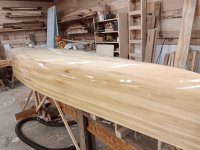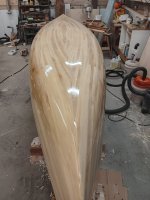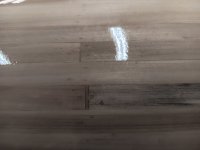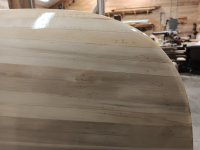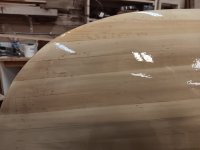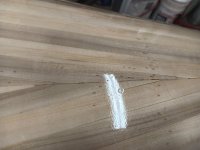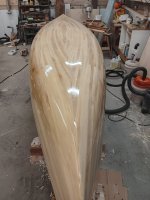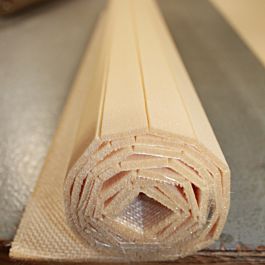Previously I went over the hull twice with 40 grit sandpaper. Once real quickly to knock off the glue drips and the really high spots. Then once a little slower for a more general smoothing. Today I went over it with 60 grit while paying a little more attention by eye and hand. This sanding gets the hull almost ready.
After that it was time to address the cracks and holes. I always use dust collection with my sander so I had a nice bunch wood powder I'd just sanded off. I mix this in with the epoxy to thicken it and give it a color that will closely match the hull. I find wood powder of the same species always comes out a little dark so I also mix in some microballoons to lighten the color slightly. The combination of wood powder and microballoons makes it easy to sand.
I then coated the entire hull with this thickened epoxy using a squeegee. This filled all the staple holes, cracks, gaps, and gouges. I then scraped it all back off the hull so the only thickened epoxy left was the stuff that was filling holes. As the epoxy started to get gummier I found it easier to remove by pushing the squeegee rather than pulling it. I'm guessing about 10 ounces remained on the hull.
In addition to the obvious benefits of filling the big holes it also fills all the little cracks and holes so there will hopefully be no epoxy leaking through to the inside of the hull when applying the fiberglass. Epoxy runs and drips on the inside make that already tedious task even worse.
Wood powder
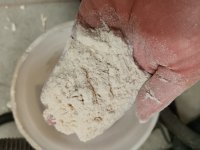
I intentionally left excess epoxy at the stems. It will sand easy enough and they need a little final shaping.
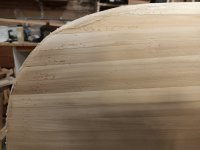
I also left it proud at the planer divots. The squeegee wanted to pull the epoxy from the divots so I used my finger to smear it on. Again, this should easily sand down.
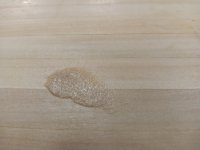
After scraping the epoxy back off the hull
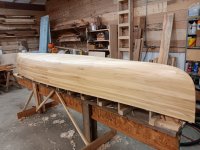
Remember all the gaps and holes that were visible from this view before?
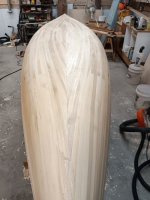
After that it was time to address the cracks and holes. I always use dust collection with my sander so I had a nice bunch wood powder I'd just sanded off. I mix this in with the epoxy to thicken it and give it a color that will closely match the hull. I find wood powder of the same species always comes out a little dark so I also mix in some microballoons to lighten the color slightly. The combination of wood powder and microballoons makes it easy to sand.
I then coated the entire hull with this thickened epoxy using a squeegee. This filled all the staple holes, cracks, gaps, and gouges. I then scraped it all back off the hull so the only thickened epoxy left was the stuff that was filling holes. As the epoxy started to get gummier I found it easier to remove by pushing the squeegee rather than pulling it. I'm guessing about 10 ounces remained on the hull.
In addition to the obvious benefits of filling the big holes it also fills all the little cracks and holes so there will hopefully be no epoxy leaking through to the inside of the hull when applying the fiberglass. Epoxy runs and drips on the inside make that already tedious task even worse.
Wood powder

I intentionally left excess epoxy at the stems. It will sand easy enough and they need a little final shaping.

I also left it proud at the planer divots. The squeegee wanted to pull the epoxy from the divots so I used my finger to smear it on. Again, this should easily sand down.

After scraping the epoxy back off the hull

Remember all the gaps and holes that were visible from this view before?


